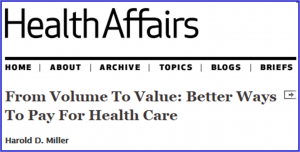 Transparency and authenticity, constant and clear communication, and a drive toward value underpin the future health system — for those health leaders who can commit to these pillars of transformational change.
Transparency and authenticity, constant and clear communication, and a drive toward value underpin the future health system — for those health leaders who can commit to these pillars of transformational change.
Leading Through Transformation: Top Healthcare CEOs’ Perspectives on the Future of Healthcare summarizes the interaction among 17 health execs who convened at the second CEO Forum held by Huron Healthcare Group. The report was released in January 2012.
Health leaders concur that regardless of the politics of the Affordable Care Act and its prospects for whole or partial survival beyond November 2012, market pressures in the health sector are driving health providers and suppliers to an environment of lower costs and higher quality. The current system as fragmented and volume-driven in unsustainable given the growing ranks of un- and under-insured, and growing role of government as insurer. The macro payment model for a health system that’s “built to last” is based on fixed payment or bundling, delivering higher quality at lower reimbursement rates.
Under that scenario, population health management is required. “We’re good at getting sick people better,” said David Feinberg of the UCLA Health System. “We fix people after they get hit by trucks. We don’t try to get the trucks to go more slowly.”
Care outside of the hospital setting is Job 1, then, where, as Surgeon General Regina Benjamin says, is where people, “live, work, play and pray.” This will also require thinking about “service lines from the perspective of the patients’ experience, not our experience,” noted Kate Walsh, President and CEO of Boston Medical Center, another attendee at the Forum.
Team-based care, with the patient at the center, will mean extending physicians’ productivity through working with complementary staff such as diabetes educators, nurse practitioners, nutritionists and other clinical professionals who can care for patients at the most appropriate point of their health journey. This approach is known as “maximizing the licenses” of staff members.
Hospitals will need to align physician staffs with this mission — which has recently meant acquiring doctors’ practices. But this ownership model isn’t the only way to align interests — other ‘rent,’ ‘borrow,’ or ‘share’ arrangements can also work. Regardless of that level of formality, success will be about building better personal relationships with physicians between institution and doctor.
Standardizing care is seen as a way to lower costs and improve quality. Ray Thompson of Trinity Mother Frances Health System thinks there’s $50 million to conserve through standardizing care. This means aggressively monitoring utilization of health resources in real-time, requiring smart use of data mining and analytics.
Keeping the staff’s collective mind of the prize of lower costs, higher quality, means leveraging new media like Twitter and Facebook and communications platforms such as webcasts and mobile phones to communicate with employees ongoing.
Health Populi’s Hot Points: It’s so easy to say the simple phrase, health care is moving from delivery and reimbursing based on volume, to value. That migration path, though, will be exceedingly bumpy and, I daresay, revolutionary. The disruptive change will mean…
- Team-based care, where doctors will work in partnership with other (“mid-level”) care providers
- Deep use of health information technology and data analytics
- Adoption and sustained use of social media and mobile technologies with both staff and consumers/patients/caregivers
- Staff with MBA skills for managing new payment models and cashflow/treasury functions
- Most transformational of all, the patient at the center of care.
Perhaps the most telling quote in the Huron report comes from Greg Brown, Chairman of Motorola who brought an external industry perspective to the Forum proceedings. He said, “People will only change when they viscerally see and feel the need for it.”
Health execs are currently saddled with falling credit ratings, growing patient bad-debt, disillusioned doctors, and increasingly demanding patients and caregivers in a national climate of a stalled macro-economy. That visceral time is Now.




 I'm gobsmackingly happy to see my research cited in a new, landmark book from the National Academy of Medicine on
I'm gobsmackingly happy to see my research cited in a new, landmark book from the National Academy of Medicine on 
 Grateful to Gregg Malkary for inviting me to join his podcast
Grateful to Gregg Malkary for inviting me to join his podcast